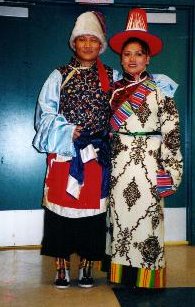 |
|
TCPC |
 |
 |
|

TCPC dance

Amdo dress

Kham dress

Kongpo dress

Save a Child
|
 |
 |
 |
Tibetan Culture
Tibetans
are unique in many ways. We have costumes that suit our way of life. Long
Chupas, for instance, require us to walk slowly and in a dignified manner.
Tibetan clothing is made for a gait that develops calmness, leisure and
energy conserving traits. Dark colours are preferred to light because they
absorb more sunlight which is desirable in a cold region such as Tibet.
Many Tibetans adorn their heads and hair with precious metals and minerals.
Our staple food is Tsampa (roasted barley flour). Although fishing, hunting
and the consumption of eggs were banned, Tibet had never known famine in
its history.
The Tibetan calendar is filled with many festivals. Losar, the Tibetan New
Year celebration can last between 3 and 15 days. Prisoners can go for one
or two months vacation to visit their families and return without any escort.
The majority of Tibetans are Buddhist and therefore are forbidden from
harming animals, insects and all living things as well as trees, rivers
and mountains. There are Tibetan Muslims, Hindus, Christians and non-believers
in Tibet. The only Christian Church in Lhasa was maintained by the Tibetan
Government until 1959 when the mission left Tibet permanently. There was
one lone imported Elephant in Lhasa (the capital of Tibet), but it was
killed during the Chinese invasion.
Since Tibetans are mostly nomads and farmers, many songs and dances are about
them. Songs and dances related to marriage ceremonies and festivities are
funny and witty. Beautiful songs about nature are common. Animal dances
are performed as a demonstration of respect for a part of our global family.
Opera is yet another favorite national pastime. Monks and high lamas have
also composed many songs and dances.
The Danger
Tibetan culture has evolved
through time history. But it has never been faced with such a daunting
challenge as it has today. Our culture is at its lowest ebb. The Chine's
state is involved in social and cultural re-engineering. China decides
what is right or wrong, good or bad, culture or civilized. Tibetans are
reduced to minority status in their own home land. The Chinese language
is forced upon Tibetans and the Tibetan language is not permitted to grow
and enrich itself. Along with our language, Tibetan culture suffers
Hope
Tibetans living in exile have to take responsibility for preserving our unique culture.
It is up to us whether to adopt our new culture or adapt to our new culture
without forgetting values such as compassion, respect for all living beings
and living in harmony with nature.
Tibetan Culture Preservation in Canada (TCPC)
Every Tibetan has a responsibility to preserve our culture. China may take away
our land, but they cannot take away our Tibetan culture. If our culture
is lost, then Tibet is lost forever.
TCPC aims to answer some of these dilemmas - with your help of course.
Tibet's
Three Provinces
U-Tsang, the land of faiths
Kham, the Land of people
Amdo, the land of perseverance
T A S H I D E
L E K
Long
live H.H. the Dalai Lama
|
|
 |
 |

H.H.the Dalai Lama
That we humans can help each other is one of our unique human capacities
We can describe
Tibetan culture as the
culture of peace
Tibetan language
sustains Tibetan
Culture
Nonviolence is a
matter of Principle
Child is a candle to lit,
not a vase to fill in
.......anon
Miles to go before I
sleep, Miles to go
before I sleep
.... Robert Frost
|
 |








